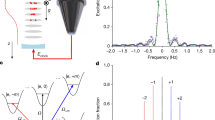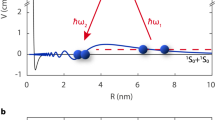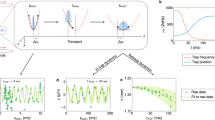Abstract
About 300 experiments have tried to determine the value of the Newtonian gravitational constant, G, so far, but large discrepancies in the results have made it impossible to know its value precisely1. The weakness of the gravitational interaction and the impossibility of shielding the effects of gravity make it very difficult to measure G while keeping systematic effects under control. Most previous experiments performed were based on the torsion pendulum or torsion balance scheme as in the experiment by Cavendish2 in 1798, and in all cases macroscopic masses were used. Here we report the precise determination of G using laser-cooled atoms and quantum interferometry. We obtain the value G = 6.67191(99) × 10−11 m3 kg−1 s−2 with a relative uncertainty of 150 parts per million (the combined standard uncertainty is given in parentheses). Our value differs by 1.5 combined standard deviations from the current recommended value of the Committee on Data for Science and Technology3. A conceptually different experiment such as ours helps to identify the systematic errors that have proved elusive in previous experiments, thus improving the confidence in the value of G. There is no definitive relationship between G and the other fundamental constants, and there is no theoretical prediction for its value, against which to test experimental results. Improving the precision with which we know G has not only a pure metrological interest, but is also important because of the key role that G has in theories of gravitation, cosmology, particle physics and astrophysics and in geophysical models.
This is a preview of subscription content, access via your institution
Access options
Subscribe to this journal
Receive 51 print issues and online access
$199.00 per year
only $3.90 per issue
Buy this article
- Purchase on Springer Link
- Instant access to full article PDF
Prices may be subject to local taxes which are calculated during checkout



Similar content being viewed by others
References
Quinn, T. Measuring big G. Nature 408, 919–921 (2000)
Cavendish, H. Experiments to determine the density of the Earth. Phil. Trans. R. Soc. Lond. 88, 469–526 (1798)
Mohr, P. J., Taylor, B. N. & Newell, D. B. CODATA recommended values of the fundamental physical constants: 2010. Rev. Mod. Phys. 84, 1527–1605 (2012)
Cronin, A. D., Schmiedmayer, J. & Pritchard, D. E. Optics and interferometry with atoms and molecules. Rev. Mod. Phys. 81, 1051–1129 (2009)
Tino G. M., Kasevich M. A., eds. Atom Interferometry, Proc. Int. School Phys. “Enrico Fermi”, Course CLXXXVIII, Varenna 2013 (Società Italiana di Fisica and IOS Press, 2014)
Peters, A., Chung, K. Y. & Chu, S. Measurement of gravitational acceleration by dropping atoms. Nature 400, 849–852 (1999)
McGuirk, J. M., Foster, G. T., Fixler, J. B., Snadden, M. J. & Kasevich, M. A. Sensitive absolute-gravity gradiometry using atom interferometry. Phys. Rev. A 65, 033608 (2002)
Gustavson, T. L., Landragin, A. & Kasevich, M. A. Rotation sensing with a dual atom interferometer Sagnac gyroscope. Class. Quantum Gravity 17, 2385–2398 (2000)
Ferrari, G., Poli, N., Sorrentino, F. & Tino, G. M. Long-lived Bloch oscillations with bosonic Sr atoms and application to gravity measurement at the micrometer scale. Phys. Rev. Lett. 97, 060402 (2006)
Dimopoulos, S., Graham, P., Hogan, J. & Kasevich, M. Testing general relativity with atom interferometry. Phys. Rev. Lett. 98, 111102 (2007)
Amelino-Camelia, G., Lämmerzahl, C., Mercati, F. & Tino, G. M. Constraining the energy-momentum dispersion relation with Planck-scale sensitivity using cold atoms. Phys. Rev. Lett. 103, 171302 (2009)
de Angelis, M. et al. Precision gravimetry with atomic sensors. Meas. Sci. Technol. 20, 022001 (2009)
Bertoldi, A. et al. Atom interferometry gravity-gradiometer for the determination of the Newtonian gravitational constant G. Eur. Phys. J. D 40, 271–279 (2006)
Fixler, J. B., Foster, G. T., McGuirk, J. M. & Kasevich, M. Atom interferometer measurement of the Newtonian constant of gravity. Science 315, 74–77 (2007)
Lamporesi, G., Bertoldi, A., Cacciapuoti, L., Prevedelli, M. & Tino, G. M. Determination of the Newtonian gravitational constant using atom interferometry. Phys. Rev. Lett. 100, 050801 (2008)
Tino, G. M. et al. Precision gravity tests with atom interferometry in space. Nucl. Phys. B Proc. Suppl. 243–244 203–217 (2013)
Tino, G. M., Vetrano, F. & Lämmerzahl, C. Editorial on the special issue on “gravitational waves detection with atom interferometry”. Gen. Relativ. Gravit. 43, 1901–1903 (2011)
Louchet-Chauvet, A. et al. The influence of transverse motion within an atomic gravimeter. New J. Phys. 13, 065025 (2011)
Kasevich, M. & Chu, S. Atomic interferometry using stimulated Raman transitions. Phys. Rev. Lett. 67, 181–184 (1991)
Lamporesi, G. et al. Source masses and positioning system for an accurate measurement of G. Rev. Sci. Instrum. 78, 075109 (2007)
Sorrentino, F. et al. Sensitive gravity-gradiometry with atom interferometry: progress towards an improved determination of the gravitational constant. New J. Phys. 12, 095009 (2010)
Foster, G. T., Fixler, J. B., McGuirk, J. M. & Kasevich, M. A. novel method of phase extraction between coupled atom interferometers using ellipse-specific fitting. Opt. Lett. 27, 951–953 (2002)
Hogan, J., Johnson, D. & Kasevich, M. in Proc. Int. School Phys. “Enrico Fermi”, Course CLXVIII (eds Arimondo, E., Ertmer, W., Schleich, W. & Rasel, E. ) 411–447 (SIF, Bologna and IOS Press, 2009)
Lan, S.-Y., Kuan, P.-C., Estey, B., Haslinger, P. & Müller, H. Influence of the Coriolis force in atom interferometry. Phys. Rev. Lett. 108, 090402 (2012)
Stellmer, S., Pasquiou, B., Grimm, R. & Schreck, F. Laser cooling to quantum degeneracy. Phys. Rev. Lett. 110, 263003 (2013)
Sorrentino, F. et al. Quantum sensor for atom-surface interactions below 10 µm. Phys. Rev. A 79, 013409 (2009)
Poli, N. et al. Precision measurement of gravity with cold atoms in an optical lattice and comparison with a classical gravimeter. Phys. Rev. Lett. 106, 038501 (2011)
Sorrentino, F. et al. Sensitivity limits of a Raman atom interferometer as a gravity gradiometer. Phys. Rev. A 89, 023607 (2014)
Storey, P. & Cohen-Tannoudji, C. The Feynman path integral approach to atomic interferometry. A tutorial. J. Phys. II France 4, 1999–2027 (1994)
Antoine, C. & Bordé, C. Exact phase shifts for atom interferometry. Phys. Lett. A 306, 277–284 (2003)
Luther, G. G. & Towler, W. R. Redetermination of the Newtonian gravitational constant G. Phys. Rev. Lett. 48, 121–123 (1982)
Karagioz, O. & Izmailov, V. Measurement of the gravitational constant with a torsion balance. Meas. Tech. 39, 979–987 (1996)
Bagley, C. H. & Luther, G. G. Preliminary results of a determination of the Newtonian constant of gravitation: a test of the Kuroda hypothesis. Phys. Rev. Lett. 78, 3047–3050 (1997)
Gundlach, J. H. & Merkowitz, S. M. Measurement of Newton’s constant using a torsion balance with angular acceleration feedback. Phys. Rev. Lett. 85, 2869–2872 (2000)
Quinn, T. J., Speake, C. C., Richman, S. J., Davis, R. S. & Picard, A. A new determination of G using two methods. Phys. Rev. Lett. 87, 111101 (2001)
Kleinevoss, U. Bestimmung der Newtonschen Gravitationskonstanten G. PhD thesis, Univ. Wuppertal. (2002)
Armstrong, T. R. & Fitzgerald, M. P. New measurements of G using the measurement standards laboratory torsion balance. Phys. Rev. Lett. 91, 201101 (2003)
Hu, Z.-K., Guo, J.-Q. & Luo, J. Correction of source mass effects in the HUST-99 measurement of G. Phys. Rev. D 71, 127505 (2005)
Schlamminger, S. et al. Measurement of Newton’s gravitational constant. Phys. Rev. D 74, 082001 (2006)
Luo, J. et al. Determination of the Newtonian gravitational constant G with time-of-swing method. Phys. Rev. Lett. 102, 240801 (2009)
Tu, L.-C. et al. New determination of the gravitational constant G with time-of-swing method. Phys. Rev. D 82, 022001 (2010)
Parks, H. V. & Faller, J. E. Simple pendulum determination of the gravitational constant. Phys. Rev. Lett. 105, 110801 (2010)
Quinn, T., Parks, H., Speake, C. & Davis, R. Improved determination of G using two methods. Phys. Rev. Lett. 111, 101102 (2013
Acknowledgements
G.M.T. acknowledges discussions with M. A. Kasevich and J. Faller and useful suggestions by A. Peters in the initial phase of the experiment. We are grateful to A. Cecchetti and B. Dulach for the design of the source mass support and to A. Peuto, A. Malengo, and S. Pettorruso for density tests on the tungsten masses. We thank D. Wiersma for a critical reading of the manuscript. This work was supported by INFN (MAGIA experiment).
Author information
Authors and Affiliations
Contributions
G.M.T. had the idea for the experiment, supervised it and wrote the manuscript. G.R., F.S. and L.C. performed the experiment. M.P. contributed to the experiment and analysed the data.
Corresponding author
Ethics declarations
Competing interests
The authors declare no competing financial interests.
Rights and permissions
About this article
Cite this article
Rosi, G., Sorrentino, F., Cacciapuoti, L. et al. Precision measurement of the Newtonian gravitational constant using cold atoms. Nature 510, 518–521 (2014). https://doi.org/10.1038/nature13433
Received:
Accepted:
Published:
Issue Date:
DOI: https://doi.org/10.1038/nature13433
This article is cited by
-
Cavity-enhanced metrology in an atomic spin-1 Bose–Einstein condensate
Frontiers of Physics (2024)
-
The MOCAST+ Study on a Quantum Gradiometry Satellite Mission with Atomic Clocks
Surveys in Geophysics (2023)
-
Locating the core-mantle boundary using oscillations of atmospheric neutrinos
Journal of High Energy Physics (2023)
-
A Decade of Advancement of Quantum Sensing and Metrology in India Using Cold Atoms and Ions
Journal of the Indian Institute of Science (2023)
-
Toward atom interferometer gyroscope built on an atom chip
Journal of the Korean Physical Society (2023)
Comments
By submitting a comment you agree to abide by our Terms and Community Guidelines. If you find something abusive or that does not comply with our terms or guidelines please flag it as inappropriate.



